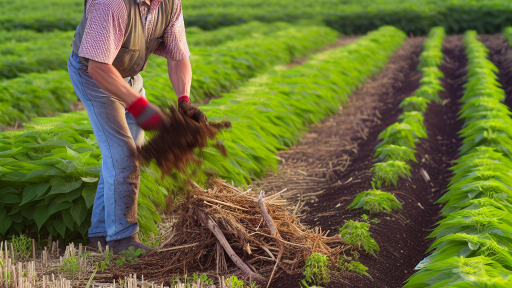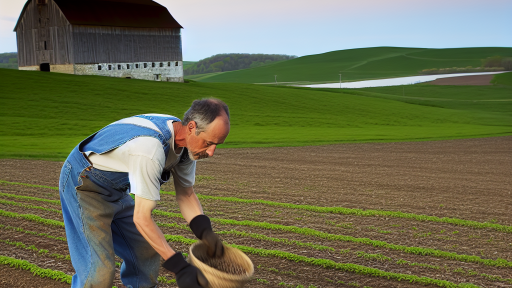Introduction to Mulching
Definition of Mulching
Mulching refers to covering the soil surface with materials.
This practice offers various benefits to gardens and landscapes.
Common mulching materials include leaves, straw, and wood chips.
These materials help retain soil moisture and suppress weeds.
Additionally, mulches can enhance soil structure over time.
Types of Mulch
Mulches fall into two main categories: organic and inorganic.
Organic mulch consists of natural materials that decompose.
Examples include wood chips, grass clippings, and shredded leaves.
In contrast, inorganic mulch includes synthetic materials like plastic.
Both types serve distinct purposes in soil management.
Benefits of Organic Mulch
Organic mulch enriches soil fertility as it decomposes.
This process adds nutrients back into the soil ecosystem.
Furthermore, it promotes beneficial microbial activity.
Organic mulch also improves soil structure and aeration.
Ultimately, it helps build a healthier growing environment.
Transform Your Agribusiness
Unlock your farm's potential with expert advice tailored to your needs. Get actionable steps that drive real results.
Get StartedBenefits of Inorganic Mulch
Inorganic mulch offers long-lasting durability.
It requires less frequent replacement compared to organic options.
This type of mulch effectively controls weed growth.
Moreover, it maintains consistent soil temperatures.
Inorganic mulch also adds visual appeal to landscapes.
How Mulching Improves Soil Structure
Enhancing Soil Aeration
Mulching enhances soil aeration significantly.
This process allows for better air circulation within the soil.
Consequently, plants receive more oxygen for root development.
Improved aeration also aids beneficial soil organisms.
Moisture Retention
Mulch plays a vital role in moisture retention.
It reduces evaporation of water from the soil surface.
This helps maintain consistent soil moisture levels.
Moreover, adequate moisture supports plant growth effectively.
Soil Temperature Regulation
Mulching helps regulate soil temperature naturally.
It keeps the soil cooler during hot weather.
In cold periods, mulch acts as insulation.
These temperature variations are beneficial for root systems.
Reducing Soil Compaction
Applying a layer of mulch reduces soil compaction.
This is crucial for maintaining soil structure and health.
Less compaction allows roots to penetrate more easily.
Additionally, it facilitates better water infiltration.
Organic Matter Addition
As mulch decomposes, it adds organic matter to the soil.
This enriches the soil with essential nutrients.
Healthy soil promotes robust plant growth.
Showcase Your Farming Business
Publish your professional farming services profile on our blog for a one-time fee of $200 and reach a dedicated audience of farmers and agribusiness owners.
Publish Your ProfileThus, mulching contributes to overall soil fertility.
Weed Suppression
Mulch effectively suppresses weed growth.
By blocking sunlight, it reduces the chances of weed germination.
Less competition allows desirable plants to thrive.
This enhances the soil quality by minimizing disturbances.
The Role of Mulch in Enhancing Soil Fertility
Improved Nutrient Retention
Mulch plays a crucial role in retaining soil nutrients.
It acts as a barrier, reducing nutrient leaching during rain.
Additionally, mulch decomposes over time, adding nutrients back into the soil.
This decomposition process enriches the soil with organic matter.
Moisture Conservation
One of the primary benefits of mulch is moisture retention.
It minimizes evaporation from the soil surface.
This moisture conservation supports plant growth during dry periods.
The result is healthier plants that can access essential nutrients.
Weed Suppression
Mulch effectively suppresses weed growth in gardens and fields.
By blocking sunlight, it prevents weed seeds from germinating.
This suppression allows for better nutrient absorption by crops.
Consequently, plants face less competition for vital resources.
Soil Temperature Regulation
Mulch helps regulate soil temperatures throughout the year.
In hot months, it keeps the soil cooler by providing shade.
Conversely, during colder months, it insulates the soil.
This temperature regulation fosters a stable environment for roots.
Increase in Beneficial Microorganisms
Applying mulch promotes a thriving population of beneficial microorganisms.
These microorganisms enhance soil fertility through decomposition.
Furthermore, they assist in breaking down organic materials into nutrients.
This symbiotic relationship supports overall soil health.
Find Out More: Crop Rotation Strategies for Healthy Soils
Benefits of Organic Mulch vs. Inorganic Mulch
Understanding Organic Mulch
Organic mulch consists of natural materials.
Examples include shredded bark, straw, or grass clippings.
This type of mulch improves soil structure over time.
As it decomposes, organic mulch releases nutrients.
Additionally, it enhances microbial activity in the soil.
This leads to better nutrient cycling for plants.
Moreover, organic mulch retains moisture effectively.
It reduces the need for frequent watering.
Consequently, this helps conserve water resources.
Advantages of Organic Mulch
Organic mulch provides numerous benefits for gardens.
- It suppresses weed growth naturally.
- It reduces soil erosion caused by wind and rain.
- It moderates soil temperature fluctuations.
- It enhances the overall aesthetic of the garden.
Furthermore, organic mulch improves soil fertility.
This leads to healthier plants and higher crop yields.
Understanding Inorganic Mulch
Inorganic mulch includes non-biodegradable materials.
Common examples are plastic, rubber, and gravel.
Showcase Your Farming Business
Publish your professional farming services profile on our blog for a one-time fee of $200 and reach a dedicated audience of farmers and agribusiness owners.
Publish Your ProfileThis type of mulch is often long-lasting and low maintenance.
It does not decompose like organic options do.
Inorganic mulch provides effective weed suppression.
Additionally, it helps with moisture retention in the soil.
However, it does not contribute nutrients back to the soil.
Pros and Cons of Inorganic Mulch
Using inorganic mulch comes with both benefits and drawbacks.
- It can last for many years without needing replacement.
- It offers varied color options for enhancing garden design.
- It prevents soil compaction in heavily trafficked areas.
However, it can create a heat buildup in hot weather.
It lacks the ability to improve soil health over time.
Thus, the choice between organic and inorganic mulch depends on specific gardening needs.
Each type serves unique purposes and offers distinct advantages.
See Related Content: Organic Solutions for Hydroponic Cultivation
How Mulching Affects Soil Moisture Retention
Understanding Mulching
Mulching involves covering the soil surface with organic or inorganic materials.
This practice significantly influences soil moisture levels in various ways.
Reducing Evaporation
One major benefit of mulch is its ability to reduce evaporation.
By covering the soil, mulch acts as a barrier against sunlight and wind.
Consequently, it helps retain moisture for a longer period.
Increasing Moisture Absorption
Mulch also enhances the soil’s ability to absorb water.
With mulched soil, rainwater can penetrate more effectively.
As a result, moisture can reach deeper layers of the soil.
Maintaining Even Temperature
Furthermore, mulch contributes to maintaining a more uniform soil temperature.
It insulates the soil, keeping it cooler in summer and warmer in winter.
This stable environment supports better moisture retention overall.
Encouraging Healthy Microbial Activity
Healthy moisture levels foster beneficial microbial activity in the soil.
Microorganisms break down organic matter, enhancing soil fertility.
Moreover, they help maintain moisture levels through improved soil structure.
Reducing Compaction
Mulching prevents soil compaction caused by rain or foot traffic.
This, in turn, allows water to infiltrate the soil more easily.
Loose soil structure promotes better moisture retention as well.
Benefits of Mulching for Soil Health
Overall, mulching effectively improves soil moisture retention.
This practice benefits plant growth and enhances overall soil health.
Uncover the Details: Enhancing Soil Health with Strategic Mulching
Impact of Mulching on Soil Temperature Regulation
Introduction to Soil Temperature Regulation
Soil temperature plays a crucial role in plant growth and development.
It affects seed germination, root functions, and nutrient availability.
Maintaining optimal soil temperature is vital for farming success.
How Mulching Influences Soil Temperature
Mulching helps regulate soil temperature by providing insulation.
This insulation protects soil from extreme temperature fluctuations.
As a result, soil remains cooler during hot weather.
In colder seasons, it retains warmth more efficiently.
Benefits of Regulating Soil Temperature
Regulated soil temperature promotes faster seed germination.
It encourages more robust root growth in plants.
Showcase Your Farming Business
Publish your professional farming services profile on our blog for a one-time fee of $200 and reach a dedicated audience of farmers and agribusiness owners.
Publish Your ProfileAdditionally, it helps in improving water retention.
Different Types of Mulch and Their Effects
Organic mulches, like straw and wood chips, are very effective.
They decompose, enriching the soil over time.
Inorganic mulches, such as stones or plastic, help reduce evaporation.
Each type serves specific functions depending on the climate and soil type.
Practical Tips for Effective Mulching
Apply mulch in a thick and even layer for best results.
Monitor soil moisture levels to avoid over-drying or excessive wetness.
Consider the type of plants when selecting mulch materials.
Enhancing Agricultural Success through Mulching
Through temperature regulation, mulching promotes healthier plants.
This practice ultimately enhances soil structure and fertility.
Investing in mulching can lead to better agricultural outcomes.
See Related Content: Sustainable Practices for Post-Harvest Processing

Mulch as a Natural Weed Suppressor
Mulching plays a vital role in weed suppression.
It creates a barrier that prevents sunlight from reaching weed seeds.
This barrier reduces the germination and growth of unwanted plants.
Types of Mulch for Weed Prevention
Different types of mulch offer varying degrees of weed control.
Organic mulch, such as wood chips or straw, can decompose over time.
However, this decomposition enriches the soil, supporting plant health.
Inorganic mulch, like rubber or landscape fabric, lasts longer but doesn’t enrich the soil.
Application Techniques for Effective Weed Control
Applying mulch correctly enhances its effectiveness in weed suppression.
Ensure a thickness of at least three inches for best results.
Be careful to keep mulch away from the base of plants to prevent rot.
Regular maintenance is necessary to replenish mulch as it degrades.
Additional Benefits of Mulching
Beyond weed suppression, mulching offers other valuable benefits.
It helps retain moisture in the soil, reducing the need for frequent watering.
Moreover, mulch acts as insulation, regulating soil temperature.
This protection supports healthier root systems during extreme weather.
The Role of Mulch in Erosion Control and Soil Conservation
Protection Against Soil Erosion
Mulch serves as a protective barrier over the soil surface.
This barrier reduces the impact of raindrops on bare soil.
Consequently, it prevents soil particles from being dislodged and washed away.
As a result, the potential for erosion decreases significantly.
Moreover, mulch retains moisture, further stabilizing the soil.
Enhancing Soil Structure
Applying mulch improves soil structure over time.
As organic mulches decompose, they enrich the soil.
This, in turn, promotes the formation of aggregates.
Stronger soil aggregates resist erosion more effectively.
Additionally, better soil structure fosters root growth.
Supporting Soil Conservation Practices
Utilizing mulch aligns with sustainable farming practices.
It enhances water retention, reducing the need for irrigation.
Furthermore, mulch minimizes weed competition for nutrients.
Showcase Your Farming Business
Publish your professional farming services profile on our blog for a one-time fee of $200 and reach a dedicated audience of farmers and agribusiness owners.
Publish Your ProfileAs a result, crops can thrive in healthier soil conditions.
This method encourages more efficient use of resources.
Creating a Favorable Microclimate
Mulch helps create a stable microclimate for plants.
It moderates soil temperature, keeping it cooler in summer.
In winter, mulch acts as insulation against frost.
This stable environment supports healthy plant growth.
Ultimately, a favorable microclimate aids in crop yields.
Integrating Mulching into Soil Management Practices
Enhancing Soil Structure
Mulching significantly improves soil structure over time.
The material decomposes, adding organic matter to the soil.
This process enhances soil porosity and aeration.
Well-aerated soil promotes healthy root development.
Additionally, mulching reduces soil compaction from rainfall.
Boosting Soil Fertility
Organic mulches are vital in enriching soil fertility.
As they break down, they release essential nutrients slowly.
These nutrients support plant growth effectively.
Moreover, mulching enhances microbial activity in the soil.
Microorganisms play a crucial role in nutrient cycling.
Water Retention Benefits
Mulch significantly improves moisture retention in the soil.
This is particularly beneficial during hot, dry periods.
It prevents water evaporation from the soil surface.
Consequently, plants require less frequent irrigation.
Disease and Pest Management
Using mulch can help deter soil-borne pests and diseases.
It acts as a barrier, reducing direct contact between pests and plants.
Additionally, organic mulches can suppress weed growth.
Fewer weeds lead to less competition for nutrients.
Practical Implementation Strategies
Choosing the right type of mulch is critical.
Organic options include straw, wood chips, and grass clippings.
Consider local availability and cost when selecting materials.
Applying mulch properly involves ensuring even coverage.
A thickness of 2-4 inches is generally recommended.
Long-term Benefits and Sustainability
Integrating mulching into soil management promotes sustainability.
It reduces the need for chemical fertilizers and pesticides.
Over time, this practice contributes to healthier ecosystems.
It fosters resilience against climate stresses.
Ultimately, consistent mulching leads to productive landscapes.
Additional Resources
Optimizing sustainable agriculture: A comprehensive review of …
Groundcover Management System and Nutrient Source Impacts on …




